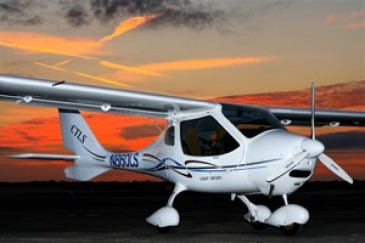CTLS - Flight Design

The Company
Flight Design General Aviation GmbH is a German aircraft design company and aircraft manufacturer, formerly based in Leinfelden-Echterdingen and Kamenz and now in Eisenach. The company started building hang gliders and paragliders in the 1980s, and ultralight aircraft 1993. The CT series first flew in March 1996 and was put into production in 1997. The aircraft line can be flown under Microlight/Ultralight regulations in many countries and under the Special Light-Sport Aircraft (SLSA) rules in the US and countries that use the ASTM standards for showing compliance. The original engineering and design work was performed in Germany, but production and all assembly of the aircraft was established in Kherson, Ukraine, to lower production costs. In June 2019 the company manufacturing the CT line, AeroJones Aviation Technology Company, announced plans for a new factory to build the design for the Asian market at the Dalu General Airport in Zhenjiang, China. The plant is expected to be operational by the end of 2019, employ 200-250 people and produce 240 CT aircraft per year.
The Aircraft
The CTLS is one of the most popular light aircraft in the world due to its great overall performance, sporty handling and class leading safety features. The new CTLS 2020 Sport Edition is now even better due to the new developments for 2020! The carbon/aramid fuselage on the CTLS is optimized for large internal space for the cabin and to reduce drag while providing cleaner airflow to the stabilizer. The smooth cantilever strutless wing also reduces drag and allows maximum visibility from the cockpit. Winglets improve climb, cruising range and aileron control at low speeds. The attractive new cowling and spinner improves cooling and reduces drag while improving access to the powerplant. While the top speed of the CTLS 2020 SE is impressively high, all CTLS fly with efficiency and low fuel consumption at all speeds. The Flight Design engineering staff created the CTLS with safety, performance and comfort in mind. The cockpit’s carbon-aramid composite cabin helps to protect you and your passenger. The engine mount and carbon fuselage attach points reduce the possibility of engine intrusion into the cabin area. Standard four–point harnesses along with crushable elements of the fuselage construction absorb energy and reduce possible loads to the pilot and passenger.
Maximum Flight Load Factors
|
With 472,5 kg (1042 Lbs.) take-off weight |
+4g / -2g |
|
With 600 kg (1320 Lbs.) take-off weight |
+4g / -2g |
Geometry
| Max. length | 6604 mm | 21′ 8″ |
| Max. height | 2342 mm | 7′ 8″ |
| Wing span | 8594 mm | 28′ 2″ |
Areas
| Wing | 9.98 m² | 107.43 ft² |
| Stabilator | 1.60 m² | 17.20 ft² |
| Vertical tail | 1.41 m² | 15.16 ft² |
Aspect ratios
| Wing | 7.29 |
| Stabilator | 3.51 |
Two models – two great engine choices: CTLS 2020 SE Rotax ™ 912S, CTLSi 2020 SE Rotax ™ 912iS
Depending on your specific requirements and preferences, choose either the well proven Rotax 912ULS, developing a reliable 100 hp with twin carburetors, or the fuel–injected, Rotax 912iS, featuring an advanced 100 hp with the fuel/air mixture precisely computer controlled for ultra–smooth power delivery, improved high altitude performance, more useful torque, reduced C02 emissions and improved fuel economy. The 912iS’ modern fuel injection also results in surer, easier starts, lower maintenance and lower operating costs all the way to its 2000-hour TBO.
| Performance at MTOW | 472,5 kg (1039.5 Lbs.) | 600 kg (1320 Lbs.) |
| VH: Max. horizontal speed | 240 km/h | 240 km/h |
| VNE: Max. permissible airspeed | 300* km/h | 300* km/h |
| Take-off run (flap +15 degree) | 140 m | 250 m |
| Take-off distance over 15 m obstacle | 250 m | 450 m |
| Max. range (30 min reserve) | 2000 km | 1800 km |
